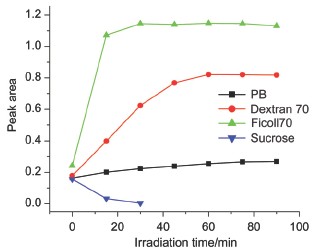| [1] Ellis, R. J. Trends Biochem. Sci. 2001, 26, 597.[2] Perham, M.; Stagg, L.; Wittung-Stafshede, P. FEBS Lett. 2007, 581, 5065.[3] Zimmerman, S. B.; Minton, A. P. Ann. Rev. Biophys. Biomol. Struct. 1993, 22, 27.[4] Minton, A. P. Biophys. J. 2005, 88, 971.[5] Minton, A. P. J. Pharm. Sci. 2005, 94, 1668.[6] Zhou, H. X. J. Mol. Recognit. 2004, 17, 368.[7] Zhu, J.; He, H. W.; Li, S. Tsinghua Sci. Tech. 2008, 13, 454.[8] Lin, Y. W.; Huang, Z. X. World Sci-tech. R & D 2006, 28, 8. (林英武, 黄仲贤, 世界科技研究与发展, 2006, 28, 8.)[9] Bazin, M.; Pierre, J.; Debey, P.; Santus, R. Eur. J. Biochem. 1982, 124, 539.[10] Sakai, H.; Onuma, H.; Umeyama, M.; Takeoka, S.; Tsuchida, E. Biochemistry 2000, 39, 14595.[11] Liang, X. Q.; Chen, G. F.; Zhang, X.; Liu, S. L.; Li, G. X. Photochem. Photobiol. B 2008, 90, 53.[12] Vorkink, W. P.; Cusanovich, M. A. Photochem. Photobiol. 1974, 19, 205.[13] Masuda, T.; Minemura, A.; Yamauchi, K.; Kondo, M. J. Radiat Res. 1980, 21, 149.[14] Winterle, J. S.; Einarsdóttir, Ó. Photochem. Photobiol. 2006, 82, 711. [15] Prusakov, V. E.; Steyer, J.; Parak, F. G. Biophys. J. 1995, 68, 2524.[16] Zhou, H. W.; Cao, H. Y.; Tang, Q.; Zheng, X. F. Acta Chim. Sinica 2011, 69, 1559. (周华伟, 曹洪玉, 唐乾, 郑学仿, 化学学报, 2011, 69, 1559.)[17] An, L. M.; Cao, H. Y.; Tang, Q.; Zheng, X. F. Chin. J. Inorg. Chem. 2012, 28, 1461. (安良梅, 曹洪玉, 唐乾, 郑学仿, 无机化学学报, 2012, 28, 1461.)[18] Wallace, C. J.; Clark-Lewis, I. J. Biol. Chem. 1992, 267, 3852.[19] Gu, X. T.; Wu, X. H.; Zhou, J. H.; Wei, S. H.; Liu, Y.; Feng, Y. Y. J. Nanjing Normal Univ. 2005, 28, 70. (顾晓天, 吴晓红, 周家宏, 魏少华, 刘颖, 冯玉英, 南京师范大学学报, 2005, 28, 70.)[20] Yang, C. Y.; Li, M.; Fu, J.; Li, X. J. Anal. Sci. 2010, 26, 153. (杨昌英, 李敏, 付静, 李昕, 分析科学学报, 2010, 26, 153.)[21] Mukherjee, S.; Waegele, M. M.; Chowdhury, P.; Lin, G.; Feng, G. J. Mol. Biol. 2009, 393, 227.[22] Venturoli, D.; Rippe, B. Am. J. Physiol. 2005, 288, 605.[23] Huang, H. C.; Jiang, Z. F.; Zhu, H. J. Chemistry 2007, 70, 501. (黄汉昌, 姜招峰, 朱宏吉, 化学通报, 2007, 70, 501.)[24] Shen, X. C.; Liang, H.; He, X. W.; Wang, X. S. Chin. J. Anal. Chem. 2004, 32, 388. (沈星灿, 梁宏, 何锡文, 王新省, 分析化学, 2004, 32, 388.)[25] Zhang, Y. J.; Tang, Q.; Cao, H. Y.; Zheng, X. F. Acta Phys. Chim. Sin. 2013, 29, 1785. (张玉姣, 唐乾, 曹洪玉, 郑学仿, 物理化学学报, 2013, 29, 1785.) |
